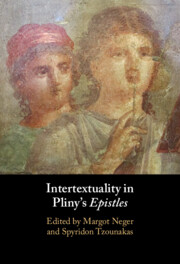Book contents
- Intertextuality in Pliny’s Epistles
- Intertextuality in Pliny’s Epistles
- Copyright page
- Contents
- Contributors
- Acknowledgements
- Abbreviations
- Introduction
- Part I Intertextuality and Interdiscursivity in Pliny’s Letters
- Part II Models and Anti-Models: Pliny’s Interaction with Oratory and Natural History
- Chapter 4 Oratorical Speeches and the Political Elite in the Regulus Cycle
- Chapter 5 Again on Corinthian Bronzes and Vases and on the Use of Cicero’s Verrine Orations in Pliny’s Works
- Chapter 6 The Elder Pliny as Source of Inspiration: Pliny the Younger’s Reception of the Naturalis Historia and His Uncle’s Writing by the Light of a Lamp (lucubratio)
- Part III Pliny and Seneca: Discourses of Grief and Posthumous Reputation
- Part IV Pliny’s Villas and Their Poetic Models
- Part V Pliny Turns Nasty: Satire and the Scoptic Tradition
- Part VI Final Thoughts: Discourses of Representation and Reproduction
- Bibliography
- General Subject Index
- Index Locorum
Chapter 5 - Again on Corinthian Bronzes and Vases and on the Use of Cicero’s Verrine Orations in Pliny’s Works
from Part II - Models and Anti-Models: Pliny’s Interaction with Oratory and Natural History
Published online by Cambridge University Press: 07 September 2023
- Intertextuality in Pliny’s Epistles
- Intertextuality in Pliny’s Epistles
- Copyright page
- Contents
- Contributors
- Acknowledgements
- Abbreviations
- Introduction
- Part I Intertextuality and Interdiscursivity in Pliny’s Letters
- Part II Models and Anti-Models: Pliny’s Interaction with Oratory and Natural History
- Chapter 4 Oratorical Speeches and the Political Elite in the Regulus Cycle
- Chapter 5 Again on Corinthian Bronzes and Vases and on the Use of Cicero’s Verrine Orations in Pliny’s Works
- Chapter 6 The Elder Pliny as Source of Inspiration: Pliny the Younger’s Reception of the Naturalis Historia and His Uncle’s Writing by the Light of a Lamp (lucubratio)
- Part III Pliny and Seneca: Discourses of Grief and Posthumous Reputation
- Part IV Pliny’s Villas and Their Poetic Models
- Part V Pliny Turns Nasty: Satire and the Scoptic Tradition
- Part VI Final Thoughts: Discourses of Representation and Reproduction
- Bibliography
- General Subject Index
- Index Locorum
Summary
Using the example of the Corinthian bronzes, this chapter aims to investigate how the encyclopaedist and the epistolographer dealt with luxury items. It analyses two famous passages from the Naturalis Historia on the Corinthian bronzes (34.6-7 and 48), two references to the same material in Pliny the Younger’s third book (3.1 and 3.6) and discusses the treatment of the topic within the frame of the Roman debate on private and public luxury. Rocchi discusses possible intertextual references made by both authors to Cicero’s speech De Signis against Verres in order to show how Cicero’s moralistic remarks on dealing with luxury items such as bronze statues and vessels propound a model of behaviour to Pliny the Younger as a donor of a bronze figurine to his home town of Comum. Finally, Rocchi addresses Pliny’s knowledge and use of the Verrine Orations more generally. In an appendix, he adds some remarks on the Corinthium signum described in Ep. 3.6 and on its lost plinth, as well as on further Corinthian bronzes mentioned in Latin inscriptions.
Keywords
- Type
- Chapter
- Information
- Intertextuality in Pliny's Epistles , pp. 116 - 128Publisher: Cambridge University PressPrint publication year: 2023

